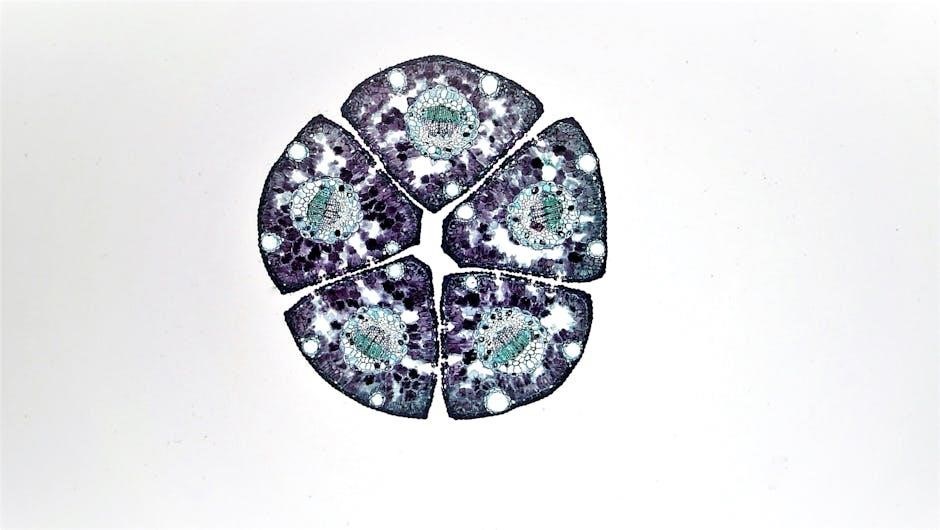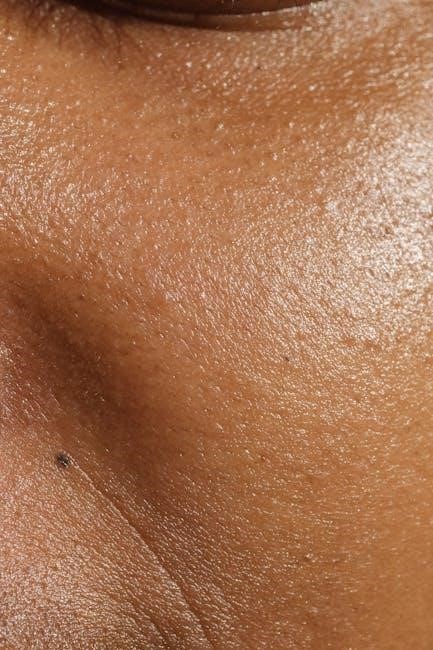Guided Tissue Regeneration (GTR) is a periodontal surgical procedure that repairs damage from advanced gum disease by regenerating lost bone and tissue․
What is Guided Tissue Regeneration?
Guided Tissue Regeneration (GTR) is a surgical dental procedure designed to regenerate lost periodontal structures, such as bone and gum tissue, around teeth affected by periodontal disease․ It involves the use of a barrier membrane to prevent unwanted cells, like gum tissue, from invading the healing area, allowing bone cells to grow and regenerate naturally․ This technique promotes the formation of new tissue and restores the supportive structures around the teeth, improving both functional and aesthetic outcomes․ GTR is often recommended for patients with advanced periodontal defects who have not responded adequately to conventional treatments․ By creating a controlled environment for healing, GTR offers a biologically based approach to tissue repair and reconstruction, making it a valuable option for long-term oral health․ The procedure is typically performed by specialized periodontists or oral surgeons with expertise in regenerative therapies․
Purpose and Benefits of GTR
The primary purpose of Guided Tissue Regeneration (GTR) is to halt the progression of periodontal disease and restore the health of the supportive tissues around teeth․ By promoting the growth of new bone and gum tissue, GTR helps to strengthen tooth stability, improve oral function, and enhance aesthetic appeal․ One of the key benefits of GTR is its ability to prevent tooth loss by addressing advanced periodontal defects that cannot be resolved with conventional treatments․ Additionally, GTR minimizes the risk of further tissue deterioration, reducing the need for more invasive procedures in the future․ It also improves the overall quality of life by restoring chewing function and boosting patient confidence․ The procedure is particularly advantageous for patients seeking a long-term solution to periodontal issues, offering both functional and cosmetic benefits that contribute to better oral health outcomes․

Factors Influencing the Cost of GTR
The cost of GTR is influenced by multiple factors, including severity of disease, type of membrane, bone grafting needs, location, and insurance coverage․
Severity of Periodontal Disease
The severity of periodontal disease significantly impacts the cost of GTR․ Advanced gum disease requiring extensive tissue and bone regeneration increases procedure complexity and time․
Type of Membrane or Barrier Used
The type of membrane or barrier used in GTR significantly influences the cost․ Non-resorbable membranes, such as titanium meshes or PTFE (polytetrafluoroethylene), often require a second surgical procedure for removal, increasing overall expenses․ Resorbable membranes, made from materials like collagen or synthetic polymers, eliminate the need for removal surgery, potentially reducing costs․ However, resorbable options may be more expensive upfront due to their advanced material composition․ Additionally, the use of custom-fit or bioactive membranes, designed to enhance healing, can further elevate the price․ The choice of membrane depends on the patient’s specific needs and the clinician’s preference, balancing both efficacy and cost-effectiveness․ This variability in materials and technologies makes the membrane selection a key factor in determining the total cost of GTR․
Need for Bone Grafting
The need for bone grafting significantly impacts the cost of guided tissue regeneration․ In cases where the bone loss is severe, bone grafting is often required to provide a stable foundation for tissue regeneration․ This procedure involves using grafting materials, which can be autografts (from the patient), allografts (donor bone), or xenografts (synthetic or animal-derived)․ Autografts are typically more expensive due to the need for a donor site and additional surgical procedures․ The complexity of the grafting process, the amount of material needed, and the surgeon’s expertise also contribute to higher costs․ Bone grafting not only increases the initial expense but may also extend recovery time and require additional follow-up appointments, further influencing the overall cost of GTR․ This makes bone grafting a substantial factor in the financial planning for guided tissue regeneration procedures․
Geographic Location
The cost of guided tissue regeneration (GTR) can vary significantly depending on the geographic location․ In urban areas, the prices tend to be higher due to the increased cost of living, higher demand for specialized dental care, and the concentration of advanced dental clinics․ Additionally, periodontists in urban centers may charge premium rates due to their expertise and the higher operational costs associated with running a practice in a city․ On the other hand, rural areas often offer more affordable rates, though the availability of skilled periodontists may be limited, potentially requiring patients to travel for treatment․ Furthermore, regional differences in healthcare regulations, taxation policies, and insurance coverage can also influence the cost of GTR procedures․ Patients should research local pricing and consider these geographic variations when planning their treatment to ensure they are financially prepared․
Dental Insurance Coverage
Dental insurance coverage for guided tissue regeneration (GTR) varies widely depending on the policy and provider․ Some insurance plans may cover GTR as a medically necessary procedure, particularly when it is required to address severe periodontal disease or to support dental implants․ However, coverage is not guaranteed and often depends on the specific terms of the policy․ Many plans categorize GTR as a surgical or advanced procedure, which may require pre-approval or higher out-of-pocket costs․ In some cases, insurance may only cover a portion of the procedure, leaving the patient responsible for the remaining balance․ It is essential for patients to review their insurance plan details and consult with their provider to understand what is covered and what additional expenses they may incur․ Pre-approval and detailed documentation are often required to maximize insurance benefits for GTR․

Cost Analysis of Guided Tissue Regeneration
The cost of guided tissue regeneration varies, influenced by factors like disease severity and materials used․ Average prices range from $500 to $2,000 per site, depending on complexity․ Costs may increase with additional procedures, so consulting a dentist for a detailed estimate is recommended․
Average Cost Range for GTR
Guided Tissue Regeneration (GTR) typically costs between $500 and $2,000 per site, depending on the severity of the case․ For example, a single-tooth procedure may cost around $500-$1,000, while more complex cases involving multiple teeth or extensive tissue damage can range from $1,500 to $2,000 or more; The cost also varies based on the type of membrane used, with resorbable membranes generally being more expensive than non-resorbable ones․ Additionally, if bone grafting is required, this can add $500 to $1,000 to the total cost․ It’s important to note that these prices are approximate and may vary depending on the dentist’s expertise and location․ A detailed consultation with a periodontist is recommended for an accurate estimate tailored to individual needs․
Cost Breakdown by Procedure Type
Guided Tissue Regeneration (GTR) costs vary based on the procedure type and complexity․ Bone grafting procedures, often combined with GTR, can range from $500 to $1,200 per site․ Membrane placement, a key component of GTR, typically costs between $300 and $700, depending on whether a resorbable or non-resorbable membrane is used․ Tissue regeneration for a single tooth may cost $1,000 to $2,500, while multi-tooth cases can range from $2,000 to $5,000․ Additional procedures, such as pocket reduction surgery, may add $500 to $1,000․ Overall, the total cost for GTR, including all necessary steps, can range from $1,500 to $6,000 or more per patient․ These estimates may vary based on the dentist’s expertise and geographic location․
Cost of Membranes and Materials
The cost of membranes and materials in Guided Tissue Regeneration (GTR) varies depending on the type and quality of the products used․ Resorbable membranes, which dissolve over time, typically range from $200 to $500 per unit․ Non-resorbable membranes, made from materials like titanium or PTFE, cost between $100 and $300; Additionally, bone grafting materials, often used alongside GTR, can add $100 to $500 to the total cost․ Growth factors or bioactive materials, which enhance healing, may range from $200 to $500․ These costs are for the materials alone and do not include surgical fees or other procedural expenses․ The choice of materials depends on the dentist’s preference, the patient’s condition, and insurance coverage, which may partially reimburse these costs․
Additional Procedures and Their Costs
In addition to the primary GTR procedure, other treatments are often required to ensure optimal results․ Bone grafting, frequently performed alongside GTR, can add $500 to $1,500 to the total cost, depending on the graft source and quantity․ Tooth extraction, if necessary, may cost $100 to $300 per tooth․ Scaling and root planing, common preliminary steps, range from $100 to $300․ Crown lengthening, sometimes needed for better access or aesthetics, can add $500 to $1,000․ Follow-up appointments and aftercare, including X-rays and check-ups, may cost $50 to $100․ These additional procedures contribute significantly to the overall expense, making comprehensive treatment planning essential to estimate the final cost accurately․

Dental Insurance and GTR
Dental insurance may partially cover GTR, depending on the policy and severity of the case․ Some plans cover up to 50% of the procedure cost․
Insurance Coverage for GTR
Dental insurance coverage for Guided Tissue Regeneration (GTR) varies widely depending on the policy and provider․ Some insurance plans may cover a portion of the procedure, particularly if it is deemed medically necessary to address conditions like severe periodontal disease or bone loss․ Typically, coverage might range from 30% to 50% of the total cost, though this can depend on the specifics of the policy․ Pre-approval is often required to determine the extent of coverage․ Cosmetic procedures or elective cases may not be covered at all․ Patients should consult their insurance provider to understand the terms and limitations of their plan․ Additionally, some policies may have annual limits or exclusions for certain types of regenerative treatments․ Verifying coverage details with both the insurer and dentist is essential to avoid unexpected costs․
Out-of-Pocket Expenses
Out-of-pocket expenses for Guided Tissue Regeneration (GTR) can vary significantly based on individual circumstances․ Patients may need to pay for portions of the procedure not covered by insurance, such as copays, deductibles, or uncovered costs․ The severity of the condition, type of materials used, and additional procedures like bone grafting can increase expenses․ On average, out-of-pocket costs may range from $500 to $2,000 or more, depending on the complexity of the case․ Patients with limited or no insurance coverage may bear the full cost, which can be substantial․ It’s essential to discuss financial obligations with the dentist beforehand and review insurance policies to understand potential out-of-pocket costs․ This helps in planning and avoiding unexpected financial burdens․ Proper planning and communication with dental professionals can ensure a clearer understanding of the expenses involved․

Pre-Approval and Documentation
Pre-approval and proper documentation are crucial steps in securing coverage for Guided Tissue Regeneration (GTR) procedures․ Patients should consult their dental insurance provider beforehand to confirm if GTR is covered under their plan․ A detailed treatment plan, including X-rays, periodontal charting, and diagnostic images, is typically required for pre-approval․ Insurance companies may request additional documentation to assess the medical necessity of the procedure․ Patients should also review their policy to understand any specific requirements or exclusions․ Delays in approval can occur if incomplete or insufficient documentation is provided․ It’s essential to start the pre-approval process early and maintain clear communication with both the dentist and insurer․ Proper documentation ensures a smoother claims process and helps avoid unexpected financial responsibilities․ A well-organized approach to pre-approval and documentation can significantly reduce stress and financial uncertainty for patients undergoing GTR․

Cost Comparison by Geographic Location
Geographic location significantly influences GTR costs, with urban areas typically charging more due to higher living expenses and specialist fees․ Rural regions may offer lower prices but fewer specialists․ International variations also exist, reflecting differences in healthcare systems and dental care costs․
Cost Variations in Different Countries
The cost of Guided Tissue Regeneration (GTR) varies significantly across different countries due to differences in healthcare systems, economic conditions, and dental care standards․ In the United States, GTR procedures are generally more expensive compared to countries with public healthcare systems, such as the UK or Germany, where costs may be partially covered by insurance․ Countries like India and Mexico often offer more affordable GTR treatments, attracting medical tourism․ Additionally, the cost can depend on the specific materials used and the expertise of the dentist․ For example, European countries may have standardized pricing, while in Asia, costs can vary widely based on clinic reputation and location․ Patients are advised to research local clinics and consult with specialists to understand the exact costs in their region;
Urban vs․ Rural Cost Differences
The cost of Guided Tissue Regeneration (GTR) can vary significantly between urban and rural areas․ In urban centers, higher demand, greater competition among dental clinics, and the availability of specialists often lead to more competitive pricing․ Urban clinics may also offer advanced technologies, which can justify higher costs․ Conversely, rural areas tend to have fewer dental specialists, and the cost of GTR may be higher due to limited access and lower patient volume․ Additionally, rural clinics may charge more for materials and procedures to cover operational costs․ Patients in rural areas might also incur travel expenses to reach urban centers for specialized care․ These factors highlight the disparity in affordability and accessibility of GTR between urban and rural regions․

Long-Term Costs and Maintenance
Long-term costs include regular follow-ups, cleanings, and potential repeat procedures․ Maintenance ensures tissue health and prevents recurrence, adding to overall expenses over time․
Ongoing Maintenance Requirements
Maintaining the results of guided tissue regeneration (GTR) is crucial for long-term success․ Patients typically require routine follow-ups with their dentist or periodontist to monitor healing and ensure no complications arise․ These visits may include cleanings, X-rays, and assessments of tissue regeneration․ On average, follow-up appointments can cost between $50 to $200, depending on the complexity and frequency․ Additionally, patients may need to use specialized oral hygiene products or medications, which can add $20 to $50 to monthly expenses․ Regular maintenance is essential to prevent infection or tissue breakdown, ensuring the durability of the procedure․ While these costs are recurring, they are generally manageable and help sustain the benefits of GTR over time․ Consistent compliance with maintenance recommendations is key to maximizing the investment in this treatment․
Cost of Follow-Up Procedures
Follow-up procedures after guided tissue regeneration (GTR) are essential to monitor healing and ensure the success of the treatment․ These procedures typically include regular check-ups, X-rays, and occasional removal of membranes or sutures․ The cost of follow-up care can range from $50 to $200 per visit, depending on the complexity of the procedure and the dentist’s fees;
Additional costs may arise if further interventions are needed, such as repairing exposed membranes or addressing incomplete healing․ Factors like the dentist’s expertise, clinic location, and the patient’s insurance coverage also influence these costs․ On average, patients may incur $300 to $600 in follow-up expenses over the first year post-treatment․ These costs are crucial for maintaining the longevity of the regeneration results and preventing future complications․
Regular maintenance is key to the long-term success of GTR, making follow-up care a worthwhile investment in oral health․

Cost-Effective Alternatives
Exploring affordable options for periodontal treatment, such as bone grafting or periodontal surgery, can offer similar outcomes at lower costs․ Newer materials and techniques may also reduce expenses while maintaining efficacy․
- Alternative treatments like bone grafting or periodontal surgery may be more cost-effective․
- Emerging bioactive materials and minimally invasive approaches could reduce overall expenses․
Less Expensive Treatments for Similar Conditions
While guided tissue regeneration (GTR) is a highly effective treatment, there are less expensive alternatives for similar periodontal conditions․ Scaling and root planing (SRP) is a common and cost-effective procedure for mild to moderate periodontal disease, costing between $100 and $300 per quadrant․ Another option is bone grafting, which can be more affordable than GTR in some cases, with prices starting at $200 per tooth․ Enamel matrix protein application is another alternative, often priced lower than GTR, promoting natural tissue healing․ Additionally, laser therapy is emerging as a less invasive option, with costs ranging from $500 to $1,000 per session․ These treatments may not offer the same regenerative benefits as GTR but can be viable for patients seeking more budget-friendly solutions․
Comparing GTR to Other Regenerative Procedures
Guided Tissue Regeneration (GTR) is often compared to other regenerative procedures, such as bone grafting, enamel matrix protein application, and tissue engineering․ Each method has unique advantages and costs․ GTR is particularly favored for its ability to promote natural tissue growth in deficient areas, making it highly effective for complex cases․ While bone grafting may be more affordable in some instances, GTR offers superior predictability in regenerating both soft and hard tissues․ Enamel matrix proteins, though less invasive, may not provide the same level of structural support as GTR․ Tissue engineering, while promising, is often more experimental and costly․ GTR strikes a balance between effectiveness and cost, especially for patients requiring long-term, stable results․ Its investment in both time and money can be justified by its proven outcomes in periodontal and implant therapies․

Financial Assistance and Payment Plans

Dental clinics often offer payment plans or financing options to make GTR affordable․ Some providers accept third-party financing like CareCredit․ Additionally, government programs or non-profits may assist eligible patients․
- Patient financing plans with low-interest rates․
- Payment schedules tailored to individual budgets․
- Special promotions or discounts for upfront payments․
Discussing financial options with your dentist can help manage the cost effectively․
Available Financing Options
For patients seeking Guided Tissue Regeneration (GTR), various financing options can help manage the cost․ Many dental clinics offer payment plans, allowing patients to spread the expense over several months․ Credit cards, particularly those with 0% interest promotions, are another popular choice․ Additionally, third-party financing companies specialize in medical and dental procedures, offering loans with flexible repayment terms․ Some providers also accept personal loans from banks or credit unions, which may have lower interest rates․ Insurance coverage, though limited, can sometimes be applied, and pre-approval is essential to understand what is covered․ Clinics may also partner with financial assistance programs or non-profits to reduce out-of-pocket costs․ Discussing these options with your dentist or financial advisor can help tailor a plan to your budget and needs․
Dental Clinics Offering Payment Plans
Dental clinics increasingly offer payment plans to make Guided Tissue Regeneration (GTR) more accessible․ Many clinics partner with third-party financiers like CareCredit or LendingClub to provide low-interest or zero-interest financing options․ Some clinics also offer in-house payment plans, allowing patients to split costs into manageable monthly installments․ For example, practices like ClearChoice and DentalWorks often provide flexible financing solutions tailored to individual needs․ Additionally, some clinics offer discounted rates for upfront payments or package deals when combining GTR with other procedures․ Patients are encouraged to discuss financial options during their consultation, as clinics may also work with insurance providers to minimize out-of-pocket expenses․ These payment plans help reduce financial stress, making advanced treatments like GTR more attainable for those needing periodontal care․
Guided Tissue Regeneration is a valuable investment in oral health, balancing cost with long-term benefits․ It restores function and aesthetics, making it a worthwhile procedure for many patients․
Is GTR Worth the Investment?
Guided Tissue Regeneration (GTR) is a highly effective procedure for addressing severe periodontal defects, offering long-term benefits for oral health․ With success rates often exceeding 80-90%, GTR can significantly improve tissue and bone regeneration, preventing tooth loss and enhancing overall dental stability․ While the initial cost may seem high, the procedure’s ability to reduce the need for future treatments makes it a cost-effective option in the long run․ Patients with advanced periodontal disease often find GTR to be a worthwhile investment, as it can restore functional chewing capacity and aesthetic confidence․ However, for mild cases, alternative treatments may be more economical․ Ultimately, the decision to invest in GTR should be based on the severity of the condition and the potential for improved quality of life․
Final Thoughts on Cost and Benefits
Guided Tissue Regeneration (GTR) is a valuable procedure for restoring lost periodontal structures, offering long-term benefits for oral health and aesthetics․
While the initial cost may seem high, the ability to preserve natural teeth and prevent further tissue loss makes it a worthwhile investment for many patients․
However, the decision to proceed with GTR should consider individual needs, budget, and insurance coverage․
Patients should discuss their options with a dental specialist to determine if GTR aligns with their goals and financial situation․
Ultimately, the procedure’s success in promoting tissue regeneration and improving quality of life often justifies the cost for those who can afford it․




Leave a Reply
You must be logged in to post a comment.